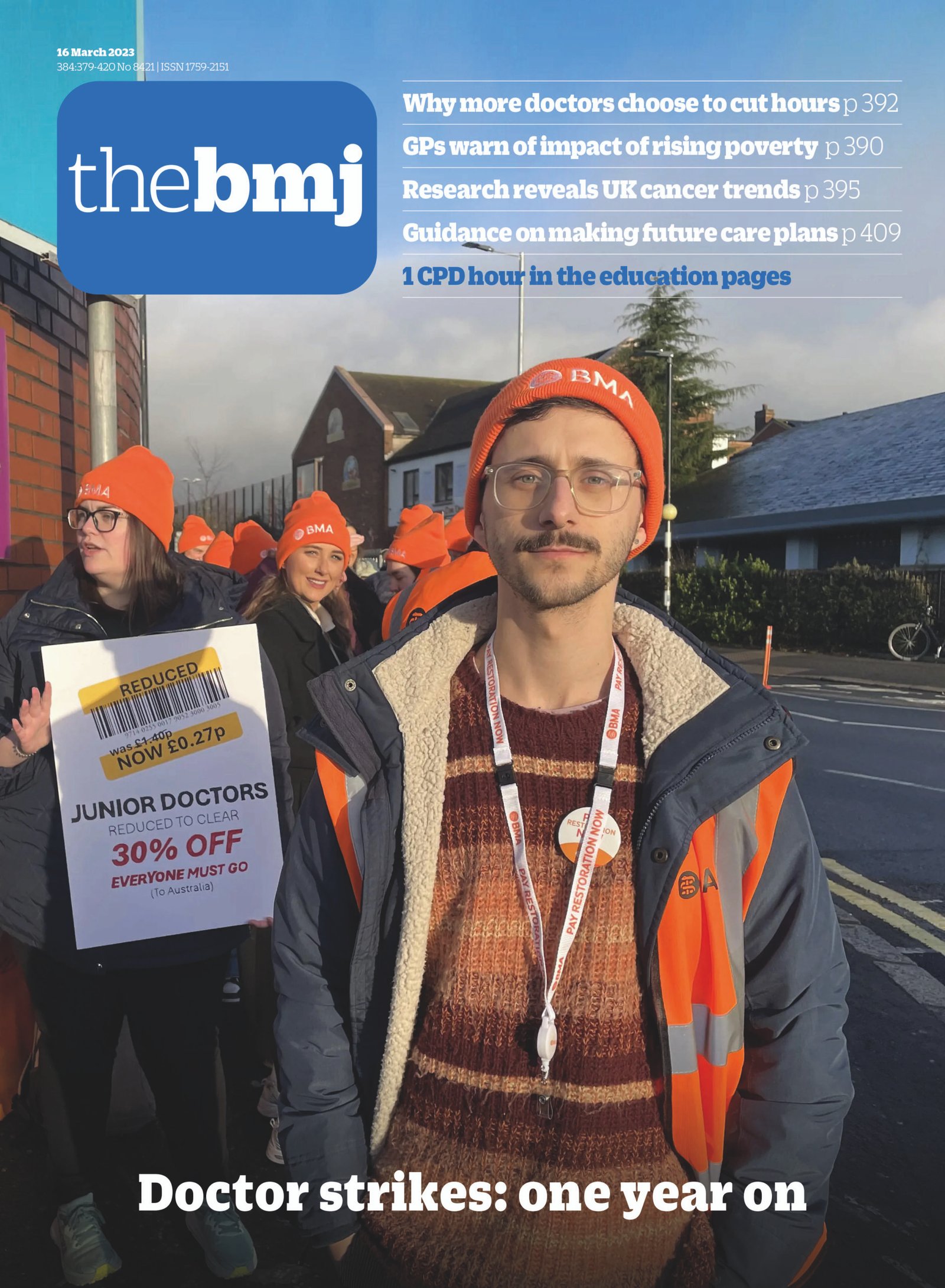- Adam Holland, clinical research training fellow1,
- Thomas D Brothers, resident physician*2,
- Dan Lewer, consultant in public health*3,
- Olivia M Maynard, senior lecturer in psychological science*4,
- Mat Southwell, project executive*5
1University of Bristol, Oakfield Grove, Clifton, Bristol BS8 2BN, UK
2Division of General Internal Medicine, Department of Medicine, Dalhousie University, Halifax, NS, Canada
3Bradford Institute for Health Research, Bradford Institute for Health Research Temple Bank House, Bradford Royal Infirmary, Bradford, UK
4University of Bristol, School of Psychological Science, Clifton, Bristol, UK
5European Network of People who Use Drugs
*These authors contributed equally and are listed in alphabetical order
- Correspondence to: A Holland adam.holland{at}bristol.ac.uk
In Canada, an average of 22 people died from opioid toxicity each day in the first six months of 2023, with 84% of these deaths involving unregulated fentanyl.1 In response to this crisis of drug related deaths, people who use drugs have advocated for models of “safer supply.” These interventions range from the testing and distribution of drugs by activists to the prescription of pharmaceuticals by clinicians and the legal regulation of drug manufacture and supply.2
In a linked paper (doi:10.1136/bmj-2023-076336), Slaunwhite and colleagues evaluated the effects of a prescribed safer supply intervention in British Columbia that was introduced in response to the dual public health emergencies of toxic drug deaths and covid-19.3 Safer supply became particularly important during the pandemic as border closures worsened the volatility of drug supply and the risks of withdrawal and overdose were exacerbated during isolation and quarantine.4 The provincial government issued “Risk Mitigation Guidance,” which allowed clinicians to prescribe opioids and stimulants to people at risk of overdose, withdrawal, or other drug related harms.5

Safer supply is controversial among some physicians and researchers, who have raised concerns about its limited evidence base, which includes no randomised controlled trials, and the risk of medications being diverted into the illicit market.67 Proponents argue that the benefits of reducing unregulated substance use through safer supply will more than compensate for any associated risks.89 The ongoing lack of consensus means that further evaluation is crucial. Although randomised controlled trials would offer the best evidence, they would be legally, ethically, and methodologically complex, as well as expensive and time consuming.10 In the context of a public health crisis, decisions must be made on the basis of currently available evidence, and further evidence must be rapidly generated.
Where interventions have been introduced without randomised controlled trials, observational methods can be used to generate evidence.11 Accordingly, Slaunwhite and colleagues evaluated the effects of the prescribed safer supply intervention in British Columbia with a retrospective cohort study.3 They compared mortality and acute healthcare visits in the week following opioid or stimulant dispensation from March 2020 to August 2021 for people receiving the intervention (n=5882) and matched controls. Their analysis suggests that opioid dispensations were associated with large reductions in risk of all cause and overdose related mortality. This contributes to a growing evidence base for safer supply interventions, including observational studies and multi-method evaluations in several Canadian provinces.12
Safer supply was introduced in British Columbia in the specific context of escalating deaths due to fentanyl and the covid-19 pandemic; however, similar interventions may reduce harms in other countries with increasing deaths from unregulated drugs. The Taliban have recently prohibited opium poppy cultivation in Afghanistan, where most of the heroin in Europe originates.13 This has led to a precipitous decline in production, which could result in the proliferation of more dangerous synthetic drugs. Of particular concern are nitazenes, potent synthetic opioids already being implicated in deaths across multiple European countries.14
Current supply reduction policies may be driving the proliferation of potent synthetic drugs, manufactured inexpensively without relying on illicit crops.15 This has obvious benefits for producers but disastrous results for consumers. More broadly, current policy responses have failed to reduce global drug use, harms, or supply, as numbers of deaths and healthy life years lost attributable to drugs have roughly doubled since 1990.15 Models of safer supply could offer an alternative avenue to reduce harms from a rapidly evolving and increasingly toxic drug market.
Proponents of safer supply face obvious challenges. Stigma has historically limited support from the public and policy makers for innovative harm reduction interventions.16 In Canada, prescribed safer supply was facilitated by strong advocacy movements led by people who use drugs and by a compatible legal framework. Services still face resistance from some politicians17; an activist led safer supply programme established by the Drug User Liberation Front has been disrupted and its leaders arrested,18 and federal funding for 21 safer supply programmes is scheduled to end in March 2024.19 Conditions in other countries are even less hospitable for safer supply innovation.16
International bodies are increasingly recognising the need for non-punitive responses to substance use and drug market regulation.2021 The evidence for safer supply is not perfect, but in countries where deaths are escalating due to toxic unregulated drug supplies, governments need to take urgent action. This means taking calculated risks in collaboration with affected populations and investing in safer supply interventions supported by a growing observational evidence base.
Footnotes
-
Competing interests: The BMJ has judged that there are no disqualifying financial ties to commercial companies. The authors declare the following other interests: AH is doing a PhD funded by the Medical Research Council (grants MR/W006308/1 and MR/X018636/1), is co-chair of the Faculty of Public Health Drugs Special Interest Group, volunteers for the Loop (a drug checking organisation), is a member of the Drug Science Enhanced Harm Reduction Working Group, and has worked on various projects advocating for the decriminalisation of drug possession and harm reduction interventions; TDB is employed as a salaried medical resident (trainee) by Nova Scotia Health and Dalhousie University, holds a grant from the Canadian Institutes of Health Research (FRN 185469) focused on injection drug use associated infective endocarditis, and practices addiction medicine and prescribes safer supply medications, but does not receive any financial benefit from doing so; MS is project executive for the European Network of People who Use Drugs (EuroNPUD); EuroNPUD has received unrestricted educational grants from Camurus and Indivior to deliver a client resource on opioid agonist maintenance treatment and to run an advocacy event at the United Nations Commission on Narcotic Drugs in March 2023, respectively; EuroNPUD has also received a grant from ViiV Europe, the donor arm of the HIV pharmaceutical company.
-
Further details of The BMJ policy on financial interests is here: https://www.bmj.com/sites/default/files/attachments/resources/2016/03/16-current-bmj-education-coi-form.pdf.”
-
Provenance: Commissioned; not externally peer reviewed.










